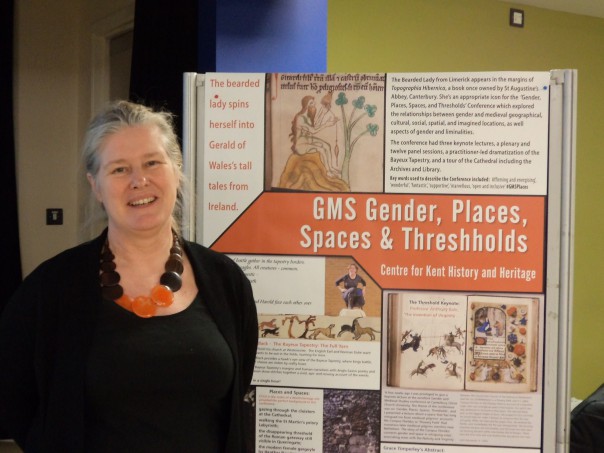The last few days have been exceedingly busy, partly because we are now a fortnight away from the Medieval Canterbury Weekend 2018 – there are still tickets available from ‘Campfire Tales’, with The Canterbury Tales, on Friday 6 April for ‘younger medievalists’ to the wide range of Medieval History talks from Friday evening until Sunday afternoon – www.canterbury.ac.uk/medieval-canterbury and also because I have been involved in several meetings about the Faversham exhibition, about working with schoolchildren on History topics and drawing up details for the next Nightingale Memorial Lecture, the joint event with the Agricultural Museum, Brook.
However, before I get to many of these, including a short report on the Lambarde Lecture on Wednesday, I thought you would like to join me in congratulating Dr Diane Heath, my colleague in the Centre, who won a Faculty Knowledge Exchange prize on Wednesday for her organisation of the Gender and Medieval Studies conference at Canterbury Christ Church in January 2017. This highly enjoyable and academically rigorous conference on ‘Places, Spaces and Thresholds’ in medieval gender studies was, as you would expect from Diane, extremely well run in a friendly atmosphere that included innovative features such as ‘Walking the Labyrinth’ and Dr Daisy Black’s one-woman narrative dramatization of the Bayeux Tapestry. Diane intends to use the £500 prize money with the other £500 KE prize that the Centre also collected on Wednesday for the ‘Tudors and Stuarts History Weekend’ to continue her ‘Crypt Creatures’ project. The next step, using the £1000, will be to commission a translation of a section from Honorius Augustodunensis’s Speculum Ecclesiae, a work that was designed for a lay audience and was probably influential concerning the decoration in Canterbury Cathedral crypt – hybrids and other fantastic beasts, which forms part of the beautification of the cathedral undertaken nine hundred years ago under Archbishop Anselm. There is an early manuscript which contains this long poem in Latin at Oxford, and this will form the core text as we move forward, and in time Diane intends to bring these crypt creatures ‘alive’ to engage with a wide range of audiences. However, this will form the third stage (the first was Professor Sandy Heslop’s lecture on Anselm’s crypt last year) and the priority now is the translation.

Diane’s KE Prize winning project.
Keeping with Diane’s work on medieval animals and the bestiary – the book of beasts – we joined several lecturers from the University of Kent for a presentation to the Ash Heritage Group at Ash Village Hall on Thursday evening. Dr Ben Marsh, with the head of history at Simon Langton Boys School, had been Ash’s point of contact, although sadly the latter was unable to be present. Consequently, Ben led his team of Dr Will Butler (History) and Luke Shoveller from Sociology by outlining the background to the development among some academics of the concept of ‘history from below’ and how he, as a ‘soft’ Leftist, saw how this could be usefully translated into a ‘People’s History of Kent’ that engaged schoolchildren in projects as part of the National Curriculum. To that end Ben, a year or so ago, had run a series of sixth form workshops on a variety of topics across time, but when it came to making these topics into individual projects for the boys, they had all turned to post-1800 sources. In many ways this plays to the strengths of Kent University, and Will gave an example of a schools’ project he had been involved in recovering the history of Sheppey Dockyard Chapel. This had involved training pupils in oral history techniques, as well as helping to bring the community together as people sought to be part of this sharing of memories and the place of the chapel in a wide range of activities that went well beyond Sunday worship. For Will and his team of university student helpers, the project gave them a successful blueprint that is now being deployed with a different community in Kent for another industry.
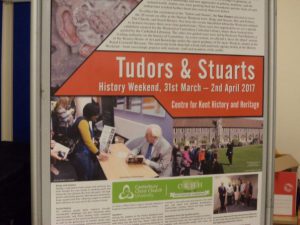
The Centre’s other KE Prize winning contribution.
As a sociologist, Luke is very interested in ideas about memory – forgetting as well as remembering – and as a doctoral Kent postgraduate he is heavily involved in projects relating to Kent’s coal industry. The new schools project is linked to the new mining museum that is being developed at Betteshanger and, as at Sheppey, oral history will be a key facet. This bringing of generations together, chimed with the audience at Ash, who have worked on their own village projects where those from the school and other youth groups such as the Brownies have worked to uncover Ash’s heritage with parents, grandparents and neighbours.
Of course, when you go further back into history the sources that can be employed in school projects change. However, ideas about memory are equally applicable for the Middle Ages, which is the period Diane and I concentrate on when working with youngsters. Diane has primarily focused on Year 7 and younger (I’ll come back to that in a minute), while I have been working with Canterbury sixth formers over several years. Introducing primary sources has been one of the developments in education over recent decades, but of necessity this has to be in the form of cherry-picked, short examples that show what the compiler of such sources books wishes to highlight. Yet working in the archives is not like that, and to give these sixth formers a taste of what it means to be a ‘real’ historian, I have held a number of workshops in Canterbury Cathedral Archives and Library, and where this has not been feasible, I have taken digital copies of whole documents or photos of objects, from funeral monuments to drinking bowls, into the classroom. Moreover, by providing context to go with these texts (and objects), with worksheets giving questions they might wish to consider, it is great to see groups and individuals thinking and questioning, and in some cases wanting to go on and explore further using the analytical techniques of close reading they are developing. For, in some cases, these documents have rarely been looked at since they were produced 500, 600 years ago, and these ‘new ways of seeing’, especially in terms of such approaches as microhistory, offer considerable scope from school projects, to local heritage initiatives, to scholarly articles. Again, such ideas were in tune with those in the audience at Ash, who have an extremely thriving Heritage Group that meet weekly to work on materials from or relating to the village and surrounding area.

Diane highlights the value of ‘Medieval Animals’.
Finally, but certainly by no means least, Diane Heath introduced the audience to her projects on ‘Medieval Animals’ and ‘Medieval Faversham’. I’ll leave aside Faversham for the time being because that will come later, but, as Diane said, ‘what is there not to like about a dragon?’ or unicorn, or phoenix? As she discussed with the audience, by exploring these creatures, especially hybrids, and bringing in ideas about colour, movement and sound, it becomes possible to reach new audiences through activities, being part of a collective, and thus begin to ask important questions in new ways that engage rather than exclude both participants and prospective audiences. Such ideas similarly chimed with the Ash audience and after a few questions there was considerable discussion among people over tea and biscuits, as those from the universities joined the locals in looking at a very impressive display of publications produced by the village’s local historians.
Moving on, I want to mention very briefly two meetings we have had in Faversham this week. On Tuesday, Professor Louise Wilkinson, Diane and I joined Cllr Nigel Kay and Geoff Wade in the Guildhall to discuss the next steps regarding the ‘Medieval Faversham’ temporary exhibition to go into the Town Council’s new Heritage Hub at 12 Market Place which the Centre is designing. The plan is for the exhibition to open in May, once the builders etc have gone, and as well as a number of display boards and pop-up banners, there will be literature available covering other heritage locations in and around Faversham – hence the ‘Heritage Hub’ idea. In addition, there will be several ‘Family Days’ with activities for children and adults, and again, although still not finalised, Diane is working with James Sladden, a teacher at Queen Elizabeth’s Grammar School and CCCU graduate, to involve Year 7 schoolchildren there in the project during the summer term.
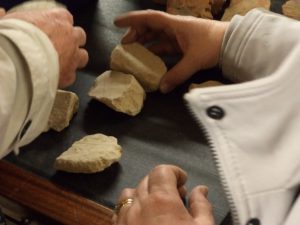
Medieval tile with incised decoration (Faversham Town Council)
Our second meeting was yesterday when Diane and I met Dr Pat Reid, the leader of the Faversham Archaeology Research Group, which is part of Faversham Society. We joined her in the Fleur’s exhibition room where the current exhibition is showcasing a brilliant display of pottery and china from the 18th century that all came from one horizon. The exhibition is well worth visiting and I won’t give the secret away of why so much from a particular period was found jumbled together and instead I’ll turn to why we were there. Pat and her team have been exceedingly active in Faversham and surrounding area, and as well as building up a considerable store of finds in their own right, they are also the guardians of finds from earlier excavations in the town, including Dr Brian Phelp’s work decades ago on the Faversham Abbey site, as well as finds belonging to Faversham Town Council. It was the latter we were especially interested in for the ‘Medieval Faversham’ exhibition, and in conjunction with activities on the Family Days. Pat very kindly showed us a range of finds, both in their store in the town and elsewhere, and we now have about 10 pieces on loan from the Town Council’s boxes. It was a truly fascinating experience, enriched by Pat’s immense knowledge about the history of Faversham (she is currently finishing off editing a book about the town), and her great knowledge about archaeology more broadly. We were extremely grateful to Pat for giving up her afternoon to take us on such an exciting journey of discovery.
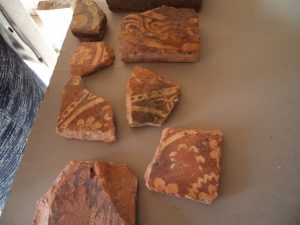
Faversham Abbey tiles (from Dr Brian Phelp’s collection)
Before I come to the final item, I just want to mention that on Wednesday the Kent History Postgraduate Group had its monthly seminar when the session was led first by Lily Hawker-Yates and then during the second hour by Janet Clayton. Lily provided material from a paper she had given recently at a postgraduate conference at Bristol University and focused on the medieval links between barrows and saints. Her case studies of the translation of St Amphibalus from a barrow to a shrine in St Alban’s Abbey in 1178, and the relatives of St Bredon from the mound outside Ludlow church to reburial inside the church was fascinating and opened up large numbers of questions about memory, competition, commemoration, and what makes a saint.
Janet kept us in the Middle Ages by exploring what it meant ‘by going to market’, specifically in the Hundred of Ruxley (she is working on Scadbury Manor and its London links). She has been piecing together from some decidedly challenging primary sources, the level and type of market availability in the St Mary Cray area, that is primarily along the Cray and Darent valleys. Consequently, some of the questions she has sought to address are whether she is looking at retail or wholesale, or a mixture of both, the type and range of goods traded, the importance of such hubs as places of social interaction, and is there evidence of specialism, perhaps bringing in the idea of connections not only with London but also Surrey. Again, this sparked a lively discussion and Dean Irwin, in particular, thinks he can help Janet regarding material from Jewish records.
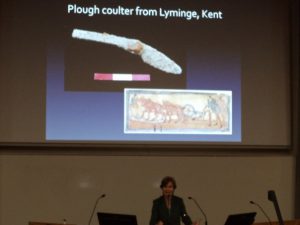
Professor Hamerow discusses the mid-Anglo-Saxon coulter found at Lyminge, Kent.
Finally, I want to mention briefly Professor Helena Hamerow’s Lambarde Lecture on rural settlement in England during what she sees as the watershed period between the mid 7th and the mid 9th centuries. Among the points she raised was that it was the time when Anglo-Saxon rural settlement became inscribed on to the landscape through the formation of ditched enclosures, which seem to conform to a measured system apparently based on the ‘short perch’, thereby reviving Roman ideas. Other innovations she stressed were changes in farming practices – the growth in livestock farming, the use of drove ways, the need to transport manure from paddocks around farmsteads to more distant fields, the expansion of the area under the plough, especially on heavy soils, the adoption of the heavy plough (see the coulter found at Lyminge, Kent), the use of plough oxen, the reintroduction of hay meadows, the return of a wider range of crops (flax, hemp, vines, orchards) – as well as centralised crop facilities – grain and malting ovens, mills (mid-Saxon mill at Ebbsfleet), large-scale grain storage facilities (Lyminge again); and specialization – fish traps, causeways, regionally specific goods and trade networks, coinage. Taking such ideas together, Professor Hamerow, considers these reflect and are a reflection of political, social and cultural change (as well as religion). These are societies that were looking longer-term, over generations not lifetimes, where inheritance and planning had become significant for farmers and landholders alike. Consequently, through the archaeological excavations over recent decades, we have come to realise that these mid Anglo-Saxon rural dwellers were building, whether we are talking about their houses or their fields, for themselves, for their children and grandchildren – a permanence that had not been seen since Roman times. And here I will leave it and thanks to those who have got to the end of this longer than usual post.
 Centre for Kent History and Heritage
Centre for Kent History and Heritage Sheila Sweetinburgh
Sheila Sweetinburgh 1598
1598